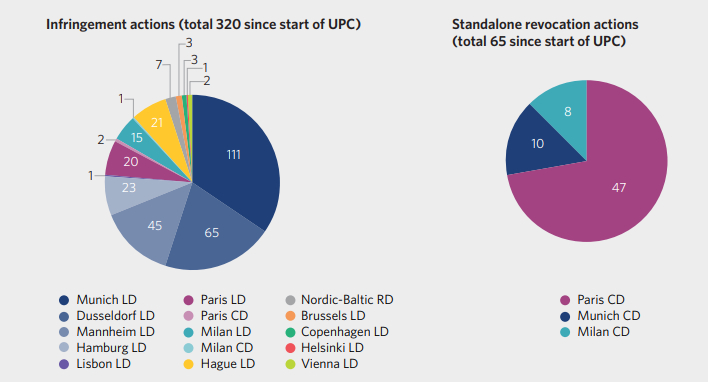- in United States
- with readers working within the Property and Retail & Leisure industries
- within Intellectual Property, Transport and Environment topic(s)
With the UPC turning two years old, we look at the practices and themes that are becoming established in this new patent court system and particular developments in the 6 months since our last briefing (linked here The UPC at 18 months).
The CJEU's decision in BSH Hausgerate v Electrolux (Case C-399/22) (BSH) made headline news in the patent world in February this year and has provided the backdrop for some interesting changes in dynamics between national patent courts and the UPC over recent months. In this briefing, we look at how the UPC has taken this decision on board and its longer-term implications for the big picture in European patent litigation, before going on the consider a selection of other developments from the UPC, including:
- Jurisdiction over pre-UPC infringements and damages and the applicable law
- Jurisdiction and opt-out (and its withdrawal)
- Claim interpretation and the UPC's doctrine of equivalence
- Front-loaded procedure and late pleadings/claims
- Criteria for PIs
- Determining imminent infringement
- Novelty – the "legal standard"
- Inventive step/Obviousness
- Added matter
- Stays and suspensive effect
- Security
- Access to pleadings
- Second medical use patents
- SEPs and FRAND at the UPC (and anti-suit injunctions)
Lastly, we touch on the potential use of UPC proceedings to promote settlement of disputes, in particular in the tech and life sciences sectors, both those already in play in multiple jurisdictions worldwide and those initiated solely in within this new patent dispute resolution system.
To start with, we examine the UPC's caseload and the continuing uptake of unitary patents.
Decisions on the merits and preliminary injunctions
Although each case turns on its own facts, it is interesting to review the UPC's decisions to see whether any trends are emerging:
- Since 1 June 2023, there have been over 50 decisions on the merits with 18 patents being revoked (and two found valid/revoked in part) and 27 held infringed (including two found infringed by default). Overall, where validity has been contested, patents have been upheld in approximately 60% of cases (this includes those held valid as amended during the proceedings).
- The balance, granted to refused, of the 30+ preliminary injunction applications so far at the UPC, is sitting at around 50/50, even allowing for the few that have been reversed on appeal.
UPC filings
The UPC case filings statistics show a strong upward trajectory through the first two years of operation, demonstrating the continuing demand for the new court.

Table shows, in brackets, first the additional cases in that 6 month period and then the increase in filings as compared to filings in the previous 6 month period (sourced from statistics published on the News page of UPC website).
 .
.
Languages
English is now firmly established as the language of the majority of proceedings. The statistics released by the UPC at the end of the first two years of its operation showed that (cumulatively) 55% of cases had proceeded or were proceeding in English (including those that have started in another language and changed to English) and 38% in German (French 2%, Italian 2%, Danish 1% and Dutch 1%).
Speed
The speed with which the court is dealing with proceedings does seem to have slowed slightly from the initial pace, with fewer cases reaching hearings within the ambitious 12 month window set out in the UPC Agreement. This was only to be expected now that the forum has become established as a reliable one for patent disputes resolution and has consequently become more popular with stakeholders, leading to more cases being filed and needing to be dealt with at the same time with a limited resource of courts. However, the UPC's continuing focus on deciding cases quickly is evident in its approach to case management, its appointment of new judges and creation of new judging panels in the busiest divisions.
Unitary patent uptake
Although the number of cases involving unitary patents (UP) at the UPC has been relatively low due to the youth of such patents, the enthusiasm for the UPC itself seems to be reflected in the statistics on requests for unitary effect (unitary patent status-UPs only – being enforceable in the UPC and not in national patent courts). By July 2025 the cumulative total of EPs registered with unitary effect, i.e. as UPs, since UPs became available on 1 June 2023, was over one third of the total EPs granted in that period. If you look at UPs registered to EU-based proprietors, this rises to almost two-fifths of those EPs granted.
At the time of going to press in July 2025, after two years of the UPC, there has been an overall uptake of UP status in newly granted patents of 22.8% (corresponding statistics for proprietors based in EPO states and EU states are 32.6% and 33.2%, respectively) with the statistics in 2025 so far being 27.8% overall (and 38.6% and 39.0% respectively).
Jurisdiction and the impact of BSH v Electrolux on the UPC and the role of "anchor defendants" and defendants in a commercial relationship
Even before the outcome of BSH, the UPC was considering these issues and, although several cases were stayed, in Fujifilm v Kodak (Dusseldorf LD, 28 January 2025) the Dusseldorf LD decided it did not need to stay proceedings to await the BSH decision and held that if a defendant was domiciled in a contracting member state (eg Germany in this case), the UPC has jurisdiction to hear the infringement action in respect of a non-contracting state (here the UK). However the court held there was no infringement and so it did not consider the UK aspect (due to the finding of non-infringement and because the revocation counterclaim did not cover the UK).
The UPC was heralded during its development as a one-stop-shop for multi-jurisdictional patent disputes. The innovation was to solve the problem of having to enforce an EP nationally in multiple separate national proceedings across the EPO territories. Although, with Romania now an additional ratifier of the UPC Agreement (UPCA) there are now 18 EU member states participating in the UPC and the unitary patent, there are several other jurisdictions in which patentees are likely to wish to enforce their patents both in the EU and the broader EPC territories (in particular other EU member states which are not currently members of the UPC: Croatia, Cyprus, Czech Republic, Greece, Hungary, Ireland, Poland, Slovakia and Spain, and in other EPC states such as Norway, Switzerland and the UK) which do not fall under the direct jurisdiction of the UPC. However, the so-called "long-arm" jurisdiction of the UPC – the ability to hear cases relating to non-UPC European patents – has received more judicial attention in the last year. In particular following the CJEU's decision in BSH v Electrolux on 25 February 2025, the spotlight has been on the UPC to demonstrate the enhanced benefits of UPC proceedings now that the CJEU had enlarged the remit of individual national patent courts with respect to their international reach.
The Paris LD was first UPC court post-BSH to tackle the issue, in Mul-T-Lock v IMC Creations (CFI 702/2024, on 21 March 2025). Here there were Spanish and Swiss patents involved and a French defendant (amongst others). The Paris LD confirmed the meaning of BSH as follows (emphasis added):
- Where validity defences are raised in an infringement action
involving EP designations from other states
- in relation to EU state patent designations (and Lugano Convention state patent designations), these can only be dealt with by the courts of the state in which the patent is registered – but this does not remove jurisdiction from the court in which the infringement action is brought to deal with the infringements of these patents.
- NB If there is a "reasonable and significant chance that the patent will be invalidated by the court of the Member State in which the patent was granted", the court where the infringement action is being brought may stay the infringement proceedings pending the outcome of the national determination(s) of the patent
- in relation to third state patents, arguments on the validity of these can be considered by the court of the state in which the infringement actions are being brought but the impact of any findings on validity will only be inter partes
(See our post on the HSFKramer IP blog www.hsfkramer.com/notes/ip for more on the CJEU's BSH decision).
The Paris LD concluded in Mul-T-Lock that the UPC had jurisdiction to hear the infringement action as regards the Spanish patent, if necessary, by suspending the proceedings, pending the decision of the national court hearing the invalidity action, if there was a reasonable and non-negligible risk that the patent would be invalidated by the court of the State granting the patent; and to hear the action for infringement of the UK part of the patent, and to rule on the validity of the title, if necessary, provided that the decision on the objection of invalidity of the patent has only inter partes effect. The Paris LD also claimed jurisdiction over the Swiss defendant's infringement of the Swiss designation of the EP involved.
The Paris LD confirmed its support of the CJEU decision by quoting from it, stating that "The patent proprietor must be able to concentrate all his infringement claims, in the event of infringement disputes in several Member States of the European Union, and obtain global compensation before a single forum and avoid the risk of divergent decisions".
There has therefore yet to be a determination relating to UK EPs although the UPC has patently not denied its jurisdiction in this respect. In April 2025, the Mannheim LD gave its decision in two cases, which had been stayed pending the outcome of the BSH CJEU judgment. The UK EP was made the subject of separate proceedings (to allow for validity assessment) and the court refused to grant a preliminary injunction (PI) in relation to the UK in the interim: "As far as Claimant requests that the Court grant a provisional injunction for the UK in the event the Court should find any reason to stay the proceedings as they relate to infringing acts carried out in the UK, or not to grant a permanent injunction for the UK until further conditions are fulfilled, the proceedings have been separated and will be dealt with in subsequent proceedings after having discussed the consequences of the ECJ's decision without there being a basis for granting such interim relief in the meantime".
To view the full article clickhere
The content of this article is intended to provide a general guide to the subject matter. Specialist advice should be sought about your specific circumstances.


